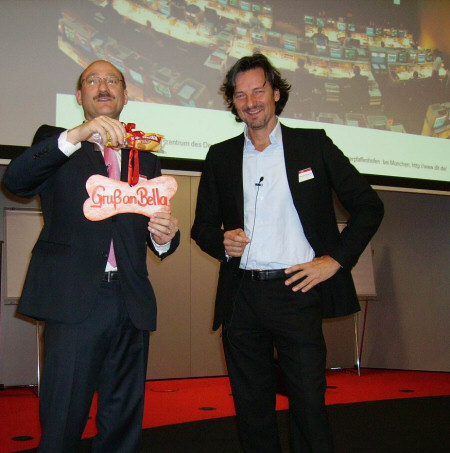Engineers and architects express their requirements in technical jargon and in numbers. They use different scales to visualize different scenarios for different tasks. We’d like that as well. Here are our first steps towards creating a scale ruler for management control.
IBM and the International Controller Association (ICV) recently hosted an event in Stuttgart, I was one of the guest speakers. At the end of the day, Rainer Linse (the director of the local Heilbronn-Künzelsau chapter) and his charming wife Sabine Reuther gave me an extra-large bone for Bella. The ICV president and CEO of Hansgrohe AG, Siegfried Gänßlen, correctly assumed that hotel bathrooms often lack a few small details and presented me with an easy-to-install, high-end, travel shower head from his company’s own production.

Almost like home: I talked a lot, Bella got a bone.
Photo: confidence consult from the 8th CCS Controlling Competence Seminar
in Stuttgart on 18 November 2010. Left in photo: Rainer Linse.
My presentation, too, focused on details – and many of them. Once again, I begged the 150 controllers in attendance for more data-dense reports. I claimed: Insights gained from measures are often overrated while the details from business activities are underrated. During the breaks, many attendees crowded around the tables in the foyer asking: How much detailed information do managers need and how much can they handle? Is there a quantitative approach to determine that? I have been pondering that last question myself for some time now. Here are a few of the observations that I have made over the past weeks and months:
- A C-level executive of an insurance company told me about the core of his controlling: 60 pages of numbers each month. On long plane trips, he would review each page thoroughly. After that time, he knew exactly where he had to investigate or take further action. Another time, I addressed the concern that the whirlwind around business intelligence often focuses too much on management and not enough on the operative units and I described the necessary change as a triangle that we need to turn upside down. He agreed but added, “It must be a rectangle – if someone on the bottom has more information, I want it on top, too.”
- Since 1997, Ermenegildo ‘Gildo’ Zegna has been chief executive of his 100-year-old, privately owned family business. In a recent Financial Times interview, he was asked which modern-day management guidelines annoy him the most and responded “that a CEO shouldn’t micromanage.” Micromanagement, he feels, is actually good.
- For our own corporate management we have launched a system that informs our top management and Director of Operations about all business activities – unfiltered (!) and in real time. The result is a mix of small texts and statistical information. More than 1,000 events are displayed newly each day. The way it is set up, we can simply skim over the short texts to understand our entire business activities in a surprising level of detail.
- A long-time customer of ours has made an unstoppable career in a company that generates around $65 billion in annual revenues. She continues to amaze me with each new step she takes. “In a project to save costs all over our enterprise, we are dealing with positions from $50 – $100 million annually. This spring, however, I visited a subsidiary that generates about $50 million in annual revenues. There, the relevant parameters lie between $300,000 and $500,000.”
This last example appears to be the key for further contemplation. Engineers and architects can describe their requirements in technical jargon backed by numbers about load capacity, statics, output, power or torque. Then, they select the appropriate scale for creating the respective visualizations. The future owner, foreman or electrician obtain different plans for the same object from the architect, but all based on different perspectives and sometimes with a completely different scale.
As in the case of my last example, the multi-billion dollar company would require different scales ranging from 1:100 to 1:1,000. My customer confirmed this view. “Our board examines long lists with up to 1,000 items. It’s a lot of work, but in a company of our size we don’t really have any other option if we want to make informed decisions.” In a company that has $65 billion dollars in annual revenues, even sums from $50 – $100 million seem like a coarse breakdown. $50 million can stand for entire R&D departments, production lines, international subsidiaries or other strategic units. We can’t change the number of items. If the company wants to continue to make strategic decisions on the C-level, the dominator is non-negotiable – which results in a scale of 1:1,000.
This ultimately changes the way we view measures, aggregates and so called KPIs. They may indicate mass effects successfully. Then it is often too late and the direct relation to the cause is missing. Our own experiences show that an aggregation and detail belong together – and that we should not underestimate our own ability to focus on many details.
